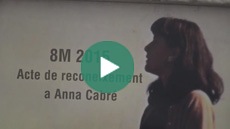Do you know Observatory for Equality at UAB?
Video explains the tasks and objectives of Observatory which highlights the main activities and actions too
Second Action Plan on disability and inclusion of the Universitat Autònoma de Barcelona
2018-2023 period. (2nd DAP)
Approved by the Governing Council at the session on March 14, 2018
Presentation

Video explains the tasks and objectives of Observatory which highlights the main activities and actions too

15th Institutional Event to commemorate International Women's Day

14th Institutional Event to commemorate International Women's Day.

XIII Institutional Conference in commemoration of the International Women's Day.

The UAB hosted on 18-20 January 2016 the research and discussion sessions of the EGERA project.

Campaign #Communicaction and invites everyone to report and respond to situations of discrimination at UAB

Action conducted by the Observatory for Equality within the campaign “Sense set de sexisme” on the occasion of the UAB’s Festival in 2014.

By the Observatory for Equality on the occasion of the UAB’s Festival in 2014.

Video in recognition of the honouree’s professional career, Fátima Bosch PhD


Dissemination video for the minute of silence and the manifesto’s lecture to commemorate the victims of gender-based violence

III International Congress of Miseal: “New challenges in Social Inclusion and Equality in Higher Education”

III International Congress of Miseal: “New challenges in Social Inclusion and Equality in Higher Education”

III International Congress of Miseal: “New challenges in Social Inclusion and Equality in Higher Education”

III International Congress of Miseal: “New challenges in Social Inclusion and Equality in Higher Education”

Campaign #Communicaction and invites everyone to report and respond to situations of discrimination at UAB

Campaign #Communicaction and invites everyone to report and respond to situations of discrimination at UAB

Dissemination video where UAB students answer the question: ‘Is there sexism at UAB?’

Dissemination video to raise awareness on the jobs by women in all fields of work.